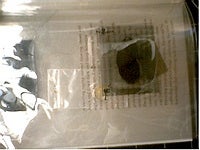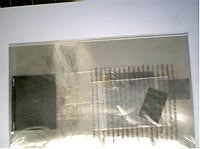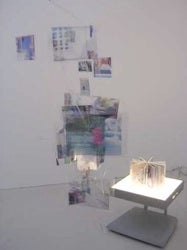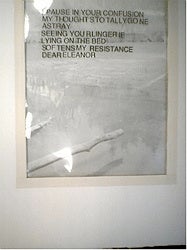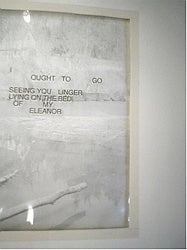![]()
Anna Trethewey
A study of book arts; form as integral to content
Before investigating book arts, it is necessary to define two differing strands of this form. The first produces highly fetishized, beautiful works of book art as a means of presenting the content. The reader’s attention is drawn to the exquisite piece because it is highly crafted, but for little other reason. The materials of the book, whilst they may compliment the content, do not critique or comment on the form in any way. Language is used as a means to convey information, and may be used visually, yet it is still presented conventionally with little or no comment on the relationship between the formal constraints of the piece and the text itself. This type of book art serves as a frame within which the content is placed: whilst they may work thematically together, there is no dynamic between the two challenging the reader to re-examine the escapist tendencies of conventional poetic writings.
In juxtaposition with this, there is another type of book art in which form and content actively comment on each other, so that questions are raised not simply about the subject matter, but also about the interpretative process of reading. To illustrate further, a comparable example of work that does not comment on its form would be a letter from Sigmund Freud to Karl D Abraham, 14th June 1912, housed in The Freud Museum, London. It is prized not only for the correspondence it contains, but also because it is in Freud’s own hand. Its rarity means that it is prized and highly valuable. The physical form of the letter is used only as a means through which to convey information. In direct relation to this, an example of a piece that examines the dynamic between form and content was Sophie Calle’s exhibition at The Freud Museum, Appointment (1999), in which she placed her own personal objects and text alongside Freud’s. By revealing memories and secrets in the context and frame of the museum, Calle is directly commenting on the nature of Freud’s work and curation. Whilst not specifically a piece of book art, this site specific attention to materiality illustrates the type of book art that I will be studying: that which would lose the relationship of dialogue between form and content if it were translated into any other medium. Johanna Drucker succinctly summarises these differences in The Century of Artists’ Books:
There are artists’ book which – to make a fine point of distinction- use language and artists’ books which are actually written. There is no moral or aesthetic hierarchy among those but they do have a different feel for language. In the first group language has an ordinariness – it is familiar, but not self-conscious, and tends to be instrumental and prosaic rather than poetic. In the second group language is appreciated for all its material properties and linguistic resonance. In such works the sonoric aspects of language such as rhythm, texture, timing and also the visual aspects are brought into the book form as part of its substance. (227) |
So whilst an artist’s book that uses language has the potential to absorb the reader, an artist’s book that is actually written has the ability to challenge the reader through self-reflexive acknowledgment of the form as integral to the content and textuality of the book.
An example of an artists’ book in the latter category is Emissions a collaboration between Susan Johanknecht and Katharine Meynell. It is a piece that explores bodily emissions and traces left by the body. Bags of mock semen, spittle and blood are included and the experience of reading it demands that you, as a reader, are reminded of your own body in relation to these substances[1]:
It was a transparent book and we used translucent ink so that with the body prints you could see your own hand straight through but you had a sense of a body print the way you do when someone leans their head against the bus window and get a kind of greasy impression of their skin. (Johanknecht qtd. in Courtney Speaking of Book Art: Interviews with British and American Book Artists. 184) |
Similarly, when displayed, it was placed on a lightbox so that the fingerprints of others that had interacted with the work were left, thereby foregrounding the content of the book in the form and context by which it was experienced. The text was printed backwards, the reader viewing it as an image before it was possible to read it. Textually, this technique highlights the duplicity of the subject matter: the internal, hidden substances of the body that are excreted, and therefore revealed by the body.
The meandering, repetitive text requires a high level of concentration from the reader:
The fear of flow and the flow of hate and fear of becoming unspeakable and unspoken, the fear of fear, the worst fear. The absorption of all that is outside within, self – contained and containing (Meynell/Johanknecht Emissions[2]) |
The text simultaneously absorbs the reader’s attention through the repetitive rhythm and seemingly straightforward syntax, yet as the reader progresses, the obfuscated, constantly redirected meaning ensures that the reader has to distance themselves from, or re-read the text before they can interpret it.
It is evident that this is an artists’ book in which it is not only the language which is actually written, but the form, layout, and mode of display that have also been carefully considered so that the materiality is foregrounded. Each element foregrounds the theme of the work, so that the reader cannot avoid the relationship that they, as a physical being, also have with piece. On a textual and physical level, the reader interacts with the piece in an innovative way, reformulating their notions of what a book should be and how they, as readers, respond. And the effect of the piece is antagonistic; whilst you leave your physical trace on the piece, the ability it has to draw your attention to the process and form of the piece will invariably leave its mark on you and your understanding of the codex form.
Ironically, to return to any attempt to define exactly what book art is leads to the acknowledgement that ‘a single definition of the term “an artist’s book” tends to be highly elusive’ (Drucker The Century 1). There are many contradictory arguments as to the factors that define artists’ books, but there does seems to be agreement that it must, in some way, acknowledge the medium in which it is communicated, i.e., it draws attention to its “bookness”.
Keith Smith provides characteristics of what is and isn’t book art stating that ‘The real bookmaker looks at a blank book and his/ her ideas emanate from the structure. It is just the opposite of sticking things into the physical object…contents should not be stuck into, but come from the format.’ (‘The List Syndrome 9[3]). This adheres to the theory that the essence of the book should be reflected in both form and content of the book, yet issues arise from the rather exclusive term ‘real bookmaker’. Whilst it is relevant to make the point that to write a book without consideration of format is to merely create a manuscript, this term also seems to exclude those working on the peripheries of what is definable as a book. He gives more specific factors of what defines book art, stating that ‘The book format, makes use of a binding, needs turning pages in order to be experienced. That is a book, and, there are damn few of them’ (‘The List Syndrome’ 9). Yet how wide a scope does this leave works on the boundaries of genres? Would this include sculptural work that pushes the notions of what a book is? Surely a function of book art is to push and challenge the expectations of readers towards unconventional readings, and that includes those with bindings in the loosest sense of the word. Les Bicknell considers Smith’s definition:
I think there is an enormously enjoyable body of work which falls outside the strict confines of Smith’s ideal. One of the attractions of book art for me is that, however hard one strives for a definition […] there is always a healthy anomoly which knocks any rule for six. |
In Smith’s defence though, he has also stated that ‘I ask questions to broaden my knowledge of traditional concepts, not to hold them as dogma, but as a foundation from which I can depart. Definitions are not an end, but a springboard’ (The Structure of the Visual Book 9). His previous definition is obviously a basis from which to work, a statement that has to be continually reassessed and re-evaluated as book art continually challenges any definition too narrow.
One such piece that uses the codex form as its basis, yet also challenges Smith’s earlier definition, is Alternative surveillance Systems for Monitored Urban Environments by Elysa Voshell, viewed at the MA Book Arts end of year show at Camberwell College of Arts, in which images are printed onto perspex and text onto acetate, and these “pages” are suspended from the ceiling at varying heights to create a mobile[4]. The theme of the work concerns public and private narratives through the city, those which are recorded or remain hidden:
Mapping a personal geography through a city space embedded with narratives, I use materials and form to raise questions about the ownership and control of space by directly engaging the viewer in the process of making meaning. (Opening the Book: Camberwell College of Arts MA Book Arts Exhibition.) |
The way that the reader catches fragments of narratives, conversations or layered fractured images is analogous to the content of the piece itself: the reader literally maps their own narrative onto the space thus foregrounding its materiality. The pages hung from the ceiling are constantly turning to reveal more layers of textuality: the reader has to engage physically with the piece, reaching their own interpretations through journeying through it. Other readers can literally be seen through the piece, highlighting the content’s exploration of fleeting encounters and chance relationships that form when travelling through a city. In effect, the kinetic nature of the piece consists of pages turning, yet not in the conventional sense, and the wires holding each page up could be considered to be the binding that holds the piece together. This is a piece right at the borders of what can considered book art: it challenges the reader’s notions of the codex form by literally taking them on a journey that refigures them in the role of author as they make their own meaning.
This is a piece of work upon which the following description could apply:
There are no hierarchies in these topless (and bottomless) networks, as paragraphs, chapters and other conventional text divisions are replaced by evenly empowered and equally ephemeral window-sized blocks of text and graphics (Coover ‘The End of Books’ 707) |
However, this description comes from the text ‘The End of Books’, in which the innovation of hypertext and the decline of printed media are discussed. It is certainly true that hypertextual and digital work does have the ability to present completely new modes of reading, where the agency of meaning if placed in the hands of the reader. By their very nature, hyperlinks can lead to multiple pathways of interpretation with the reader making the piece anew each time it is read. The following is expressed in the article:
Unlike print texts, hypertext provides multiple paths between text segments, now often called “lexias”[…]With its webs of linked lexias, its networks of alternate routes (as opposed to print’s fixed undirectional page-turning) hypertext presents a radically divergent technology, interactive and polyvocal, favoring [sic] a plurality of discourses over definitive utterance and freeing the reader from domination by the author. Hypertext reader and writer are said to become co learners or co-writers, as it were, fellow travelers [sic] in the mapping and remapping of textual (and visual, kinetic and aural) components. (Coover 716) |
Whilst this article is extremely celebratory of digital media, it underestimates the innovative qualities that book artists bring to the codex form. Many of the factors that digital media is praised for, have been experimented with in the codex form. Coover argues that ‘hypertext is a ‘truly new and unique environment. Artists who work there must be read there’ (709), yet boundaries of author/reader relationships have been blurred, and the constraints of conventional codex forms have been continually challenged by book artists before, and concurrently to, the advent of digital media. Similarly, book arts, as well as digital arts, must be judged and interacted with in their original format: the form is integral to the overall self-reflexivity of the piece.
In conclusion, all the examples examined thus far in some way involve the reader in the interpretative process of authoring their own work thereby challenging the reader to examine their own role when experiencing the work. Expressing work in a format that acknowledges both form and content as integral to each other highlights readerly expectations not just of book arts but all interpretative processes, thus pushing forward the definition of book arts and the very basis of interpretative conventions.
This excerpt is part of an article on the codex and digital work by Anna Trethewey. To obtain a copy of the whole piece, please email annatreth@googlemail.com.
[1] See accompanying pictures 1 and 2. (Back to text)
[2] For this, as with the other artist’s books to be discussed, no page numbers are included to sufficiently reference the quotes. Photographs of the texts are included at the end of this article to illustrate examples further. (Back to text)
[3] This article is taken from Les Bicknell’s Are There Any Limits to What Can be Called Book Art? (Essex: The Artists, 1994). This conceptual, concertina bound book presents a series of essays by book artists, yet doesn’t have any page numbers. There are four essays, with comments from Les Bicknell placed between. Its layout makes it very hard to simply allocate page numbers throughout, so a system of counting the individual pages in each essay was used, so whilst there may seem to be repetition of page numbers, this refers to the essays as singular units. For Bicknell’s comments, no page numbers were allocated. (Back to text)
[4] See accompanying picture 3. (Back to text)
Susan Johanknecht and Katharine Meynell, Emissions |
|
Susan Johanknecht and Katharine Meynell, Emissions |
|
Elysa Voshell, Alternative surveillance Systems for Monitored Urban Environments |
|
Keith Smith, In Between Lines |
|
Keith Smith, In Between Lines |
Works cited
Calle, Sophie. Double Game. London: Violette Editions, 1999.
Coover, Robert. ‘The End of Books’. Montfort and Wardrop-Fruin. 706-709
Courtney, Cathy. Speaking of Book Art: Interviews with British and American Book Artists. California, London: Anderson-Lovelace; Red Gull, 1999.
Drucker, Johanna. Figuring the Word: Essays on Books, Writing and Visual Poetics. New York City: Granary Books, 1998.
- - - The Century of Artists’ Books. New York City: Granary Books, 1995.
Johanknecht, Susan and Katharine Meynell. Emissions. London: Gefn Press, 1992.
Smith, Keith. In Between Lines. Rochester, New York: The author, 1988.
- - - ‘The List Syndrome.’ Bicknell.
- - - The Structure of the Visual Book. Rochester, New York: Keith A. Smith Books, 1994.
Voshell, Elysa. Alternative surveillance Systems for Monitored Urban Environments. Camberwell: The Artist, 2004.
Anna Trethewey lives and works in London. She works as a teacher and has run poetry and music workshops as part of the Creative Partnerships initiative to place poets in Slough schools. In 2005 she completed the MA in Poetic Practice at Royal Holloway, University of London.
